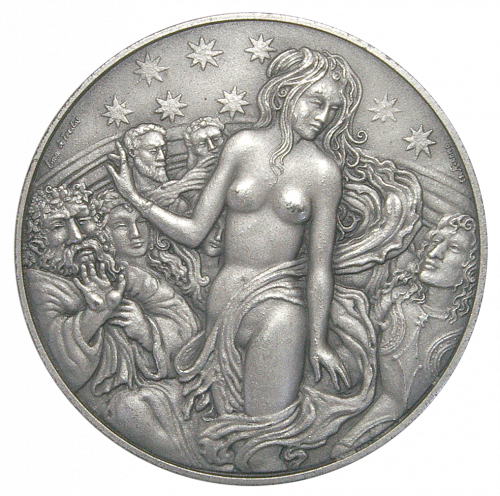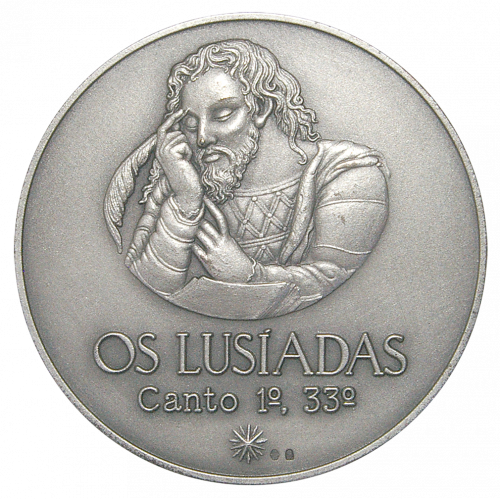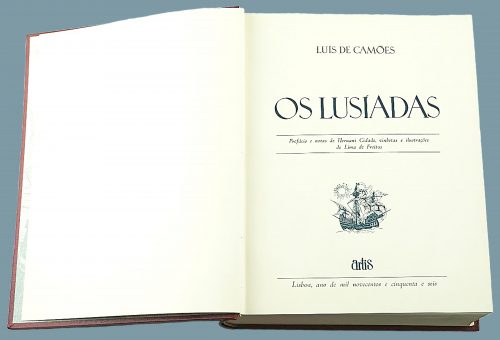M091
Sterling Silver, AU
50 mm (2”), 40 grams
HISTORY: Luís Vaz de Camões (1524‒1580) was one of Portugal’s most important and beloved poets. His epic story, Os Lusíadas (The Lusiads), was published in 1572 as a 1,102-stanza (verse), 10-canto (chapter) book. It was written in the ottava rima poetic style, which originated in Italy by Giovanni Boccaccio (1313‒1375) two centuries earlier than the epic poetry of Portugal’s de Camões. This style consists of an 8-line verse with 11 syllables each and a rhyming pattern ABABABCC (see Sample 1). The tale is as much about the celebration of Portuguese navigator and explorer Vasco da Gama (1460‒1524) and his discovery of an ocean route to the west coast of India as it is about the passionate history of Portugal.
On July 8, 1497, da Gama set sail from Lisbon with a fleet of four ships, setting course south around the tip of Africa because the Mediterranean/Persian Gulf route was fraught with danger. They then sailed north along the African coastline, establishing relations with numerous cultures, and arrived at Malindi (in present-day Kenya) on April 14, 1498. Ten days later, the four ships began their crossing of the Indian Ocean, arriving on May 20, 1498, at the beaches of Calicut, India, thereby successfully establishing a spice trade between India and Portugal.
However, de Camões was a poet, not a historian. His influences were taken from the epic poems of the Greek Homer (The Odyssey) and the Roman Virgil (The Aeneid). On the morning of demarcation in Lisbon, da Gama was surrounded by the Greco-Roman deities Bacchus and Venus. Bacchus, who was disguised as a Moor (Persian) and who represented the east, opposed the voyage; Venus, however, supported the voyage and hushed Bacchus.
The story really began after da Gama rounded Africa. Bacchus attempted to arrange a shipwreck, attacking da Gama and his crew. Venus intervened and the voyage continued. Two of the four ships, however, were lost on the historic first trip. The adventurers finally arrived along the India coast (Kozhikode, known as the “City of Spices” during the Middle Ages) and established positive trade relationships.
On the return journey, the explorers chanced upon an island that Venus had prepared for them. Nymphs greeted the sailors and rewarded them for all their labors, singing songs of Portugal’s glorious future. Vasco da Gama and his crew then set sail for their homeland.
OBVERSE: Lima de Freitas (1927‒1998) was a Portuguese artist, having illustrated over 100 books during his remarkable career. In 1956, Lisbon publisher ARTIS produced a new edition of Os Lusíadas with a preface and notes by Hernâni Cidade and illustrated by de Freitas (see Detail 1). In 1981, the illustrations were used to create the themes for a series of medals by sculptor A. Cândido (possibly Portuguese medalist Domingos António Cândido).
The scene is of Bacchus, to the left, hand outstretched in opposition to the voyage. A youthful da Gama, to the right, looks to Venus in the center, who returns his gaze as she raises her right hand to quiet the aggression of Bacchus and his followers behind. The signature of “Lima de Freitas” is at 10 o’clock; “ESC ACândido” (stylized) is at 2 o’clock.
REVERSE: A contemplative de Camões, in a thoughtful writing moment with quill in hand, is featured front and center. Beneath is “OS LUSÍADAS” (his major life’s work) and the poetic line from canto 1, line 33 (“Canto 1°, 33°”), which describes the scene on the obverse of this medal. In the exergue is a bursting star, followed by two stamped mint marks, attesting to both the minting and the silver authenticity.
EDGE: Smooth.
SAMPLE 1: This is an example of de Camões’s ottava rima, which is a poetic form consisting of 8 lines, each with 11 syllables, and a rhyming pattern of ABABABCC. Os Lusíadas opens with the following verse:
Original Portuguese text:
As armas e os barões assinalados,
Que da ocidental praia Lusitana,
Por mares nunca de antes navegados,
Passaram ainda além da Taprobana,
Em perigos e guerras esforçados,
Mais do que prometia a força humana,
E entre gente remota edificaram
Novo Reino, que tanto sublimaram;
—Luís Vaz de Camões, Os Lusíadas, lines 1-8
Translated text:
The feats of Arms, and famed heroick Host,
from occidental Lusitanian strand,
who o’er the waters ne’er by seaman crost,
farèd beyond the Taprobáne-land,
forceful in perils and in battle-post,
with more than promised force of mortal hand;
and in the regions of a distant race
rear’d a new throne so haught in Pride of Place:
—Translated by Richard Francis Burton (1880)
Publishers, London: Bernard Quaritch, p. 5
Alas, 1,101 stanzas later, our story ends—or, perhaps, begins …



